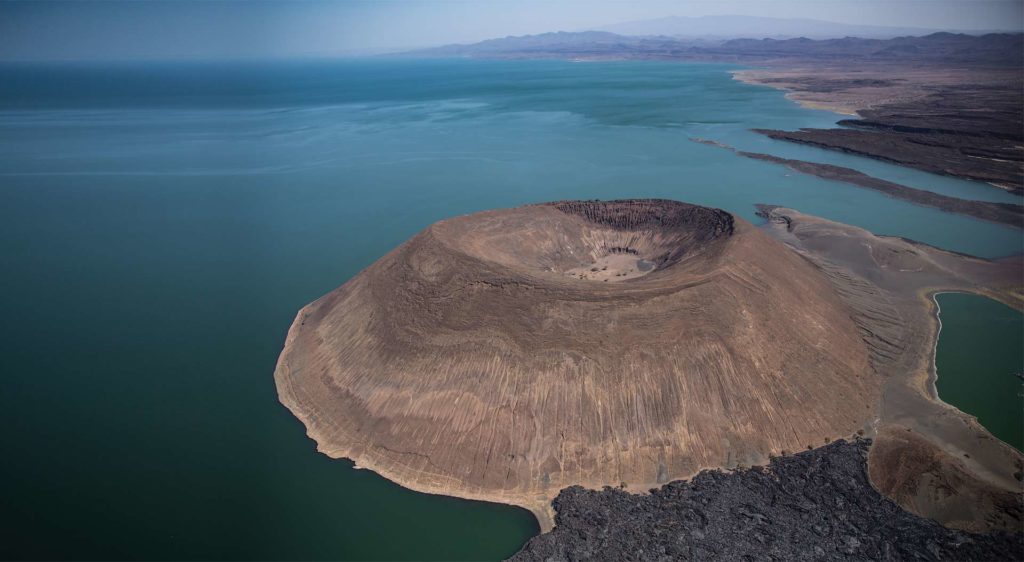
The Turkana People
In the far north of Kenya, on the searingly-hot, wind-whipped shores of Lake Turkana, lives a group of people known to their fellow Kenyans as the Turkana. They call themselves The People of the Grey Bull.
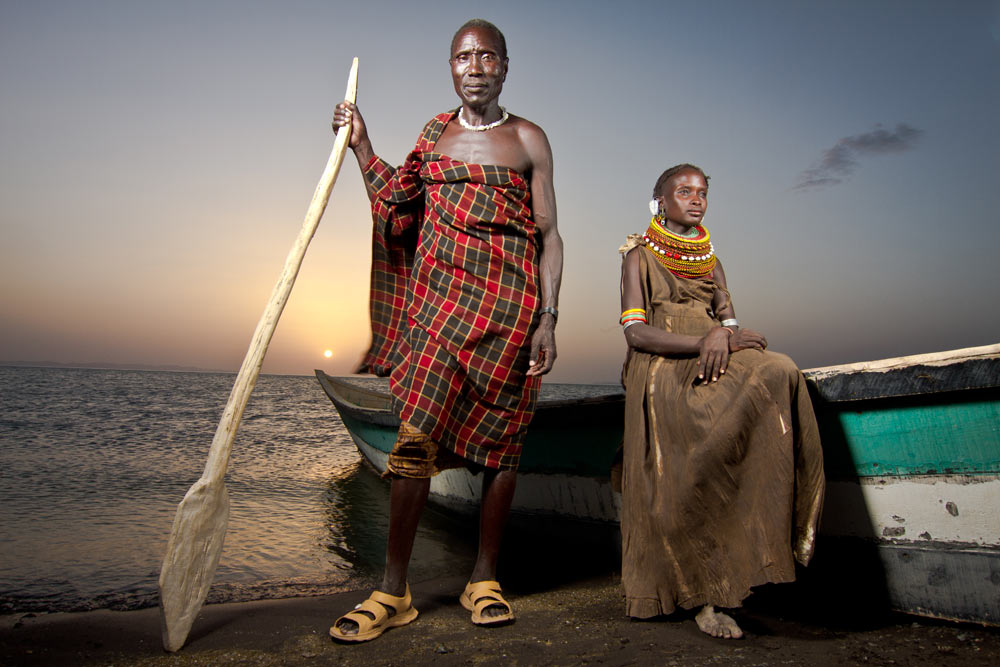
Tall and elegant with finely etched faces, these people speak a language called Turkan while their name, Turkana, is thought to translate as ‘the people of the caves’. In this lies the clue to the ancient mystery of where the Turkana came from. Nilotic by race, some say they came from Sudan, others from Ethiopia, but all agree that around three hundred years ago the Turkana settled in a mountainous region of northeastern Uganda where caves are plentiful. As to why they left this place, the Turkana, who are lyrical storytellers, have their own explanation. It goes something like this:
The legend of the grey bull
Many moons ago, our people lived in a land of mountains and forests. One day, a group of young warriors were herding their long-horned Zebu cattle across the wide plains when the leading bull, a massive grey beast with horns set so far apart that a man might not touch the tips of both at once, raised his head, cocked his ears and set off at a brisk trot. This was unusual: the plains were hot and the herds tired; but, knowing that the other cattle would follow the grey bull, the warriors set off in his wake. Many days passed as the warriors followed the tracks of the bull; he was moving fast. Finally they arrived in a deep valley bordered by lilac-grey mountains and set about with berry-laden bushes. In the distance sparkled a vast jade green lake. In the foreground grazed the grey bull.
The warriors rushed forward to rope the bull, but a voice stopped them. ‘Leave him in peace,’ it said, ‘he has brought you here according to my will.’ It was an old, cracked voice that whistled like the wind; and it came from an old lady who sat beneath a bush, her lap filled with ripe berries. ‘I am Neyace’, she said, ‘follow me and I will take you to a place of peace and fertility where I will teach you to make fire. Bring your cattle.’ Awed, the warriors followed as, stick in hand, the old lady led them forward. As night fell, they entered a silent valley filled with berry bushes. ‘Live here,’ said Neyace, ‘and send back for your maidens.’ Impressed, the warriors did as they were bid. Henceforth, these people were known as The People of the Grey Bull.
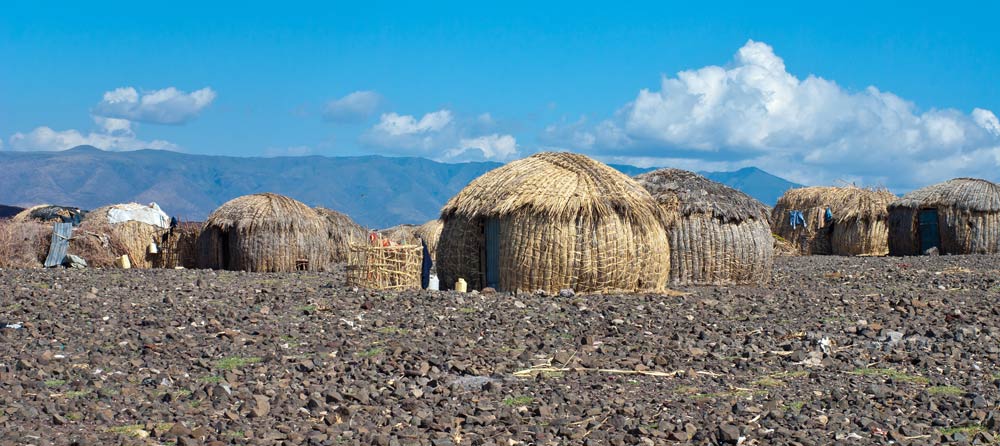
The Turkana are herders at heart
Today, the Turkana people still herd their cattle, which provide them with meat, milk and blood; they are also very fond of berries. Brave warriors, inspired creators of delicate weaponry, and skilled basket-makers, they work with leather, wood, shells, horns, gourds and plumes to make headdresses so fabulous that each man carries a small stool upon which he might rest his head, resplendent with feathers and blue-dyed mud, at night. Dwellers in a harsh land, these proud and restless nomads are born survivors.
A man with only one wife is a like a man with one leg
Though increasingly diversifying into fishing and agriculture, the Turkana are herders at heart. And a man’s ability to build his herd determines whether or not he will marry. Bride prices are high, sometimes calling for over one hundred beasts. So you will often find a man to be much older than his wife; and to have more than one wife to help him keep his herds. A man with only one wife, says an old Turkana proverb, is like a man with one leg.
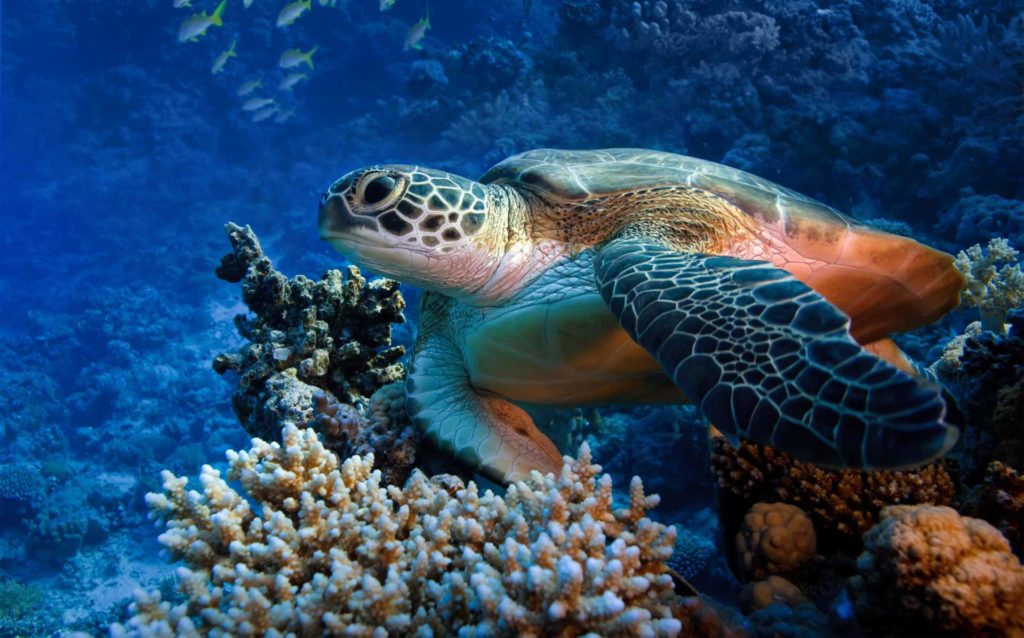
Diani day trips: snorkelling from a traditional dhow
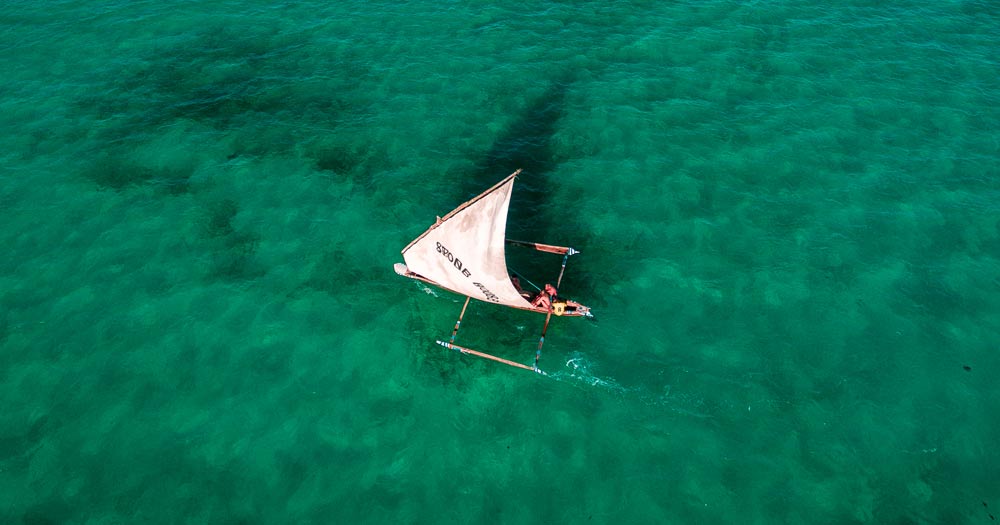
Diani is one of the world's most popular spots for a snorkelling safari. Here the traditional dhows, known as ngalawa, fish the clear blue waters of the lagoons. These, the smaller cousins of the mighty Jahazi, are dugouts some 5 metres in length. Their hulls have been hand-gouged from a single tree trunk, they’re steadied by two timber outriggers and their sails are sewn from sugar sacks. Navigation is by the sun and the crew have only spears to catch the reef fish. But, as the sun climbs higher in the sky, fishing is over for the day. And now the ngalawa offer snorkelling trips.
Such trips require precision timing. The captain must judge the tide so as to ensure that the swimmers are not scraping the coral with their fins or so high above it as to not be able to see anything but a swirl of water. The ngalawa captains, however, know their craft. And now, after a burst of Swahili, the two-man crew hurl the rusted anchor into the sea. It catches. The vessel stills. And now it’s your turn.
To get into the water, you have to first slip off the side of the dugout; then dip under the outriggers. It’s a clumsy manoeuvre that only gets clumsier as you wrestle with your mask, snorkel and flippers. The mask steams up, salty water comes down the snorkel. There’s a lot of hawking, blowing and spitting. You wonder why you’re doing this.
Ocean wonderland
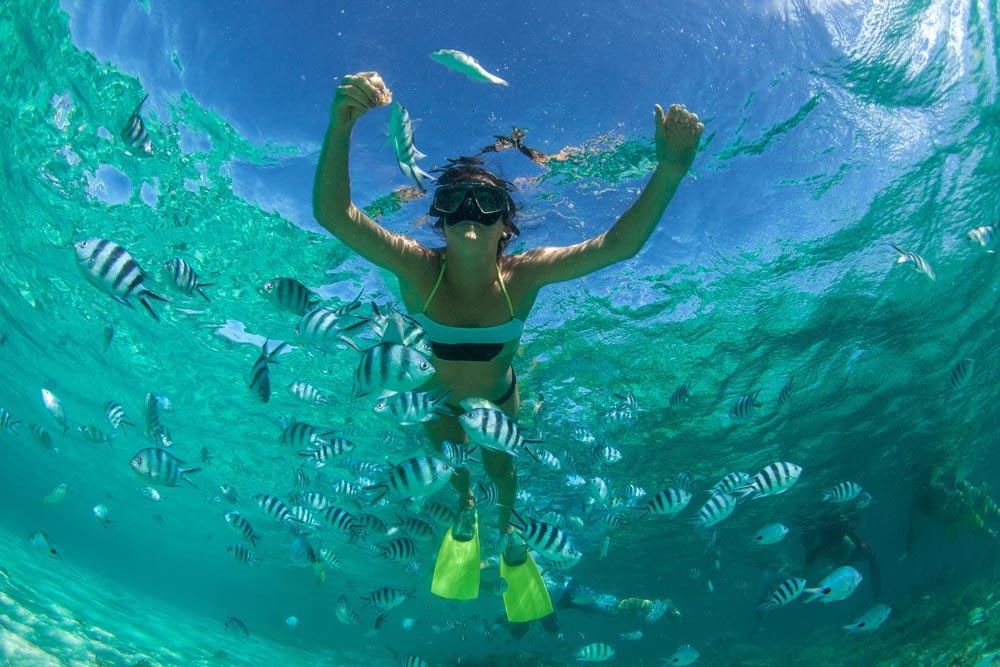
And then you put your face into the water. And you know. Because it’s a wonderland down there. Great curtains of fish shimmer amid shafts of silver light. Some are zebra-striped with thick-yellow-Mick-Jagger lips; others appear like golden angels. Translucent sea horses rock along like marine wildebeest, turtles potter with lazy grace, anemones bloom, the fluted mouths of giant clams yawn. Utterly fascinated, you drift far from the ngalawa. The coral manifests in a thousand different shapes: stag horns, pin cushions, undulating quilts and stark cliffs. Adrift in a blue-green world, you lose all sense of time.
Until the captain comes to find you, his eyes huge behind his mask. He gesticulates that time is UP.
The world above the water seems unnaturally bright and, as you swim back to the boat, you’re aware, as never before, of all that lies beneath. Already, though, the magic is fading into memory. As the dhow skims back to shore, its progress is mirrored by flights of roseate terns. Their wings flick the water as they execute a series of precision turns. On the dhow there’s a feeling of shared experience; of esprit de corp. And now, howsoever briefly, you are part of the crew. Part of the dhow. Part of history.
Diani snorkelling: the Kisite-Mpunguti Marine National Park and Reserve
The best site for snorkelling from Diani Beach is the Kisite-Mpungutu Marine Park. This pristine park covers 28 sq km of crystal-clear waters and beautiful coral reefs - and swimmers are often treated to frequent dolphin and turtle sightings. All the south coast hotels will be able to organise full- or half-day trips, or feel free to practice your haggling skills with the fishermen on the beach. All equipment - for adults and children - will be provided by the tour guide.
The marine park boasts over 250 recorded fish species and 70 resident dolphins as well as turtles, whales, 56 types of coral, sea grass and gastropods.
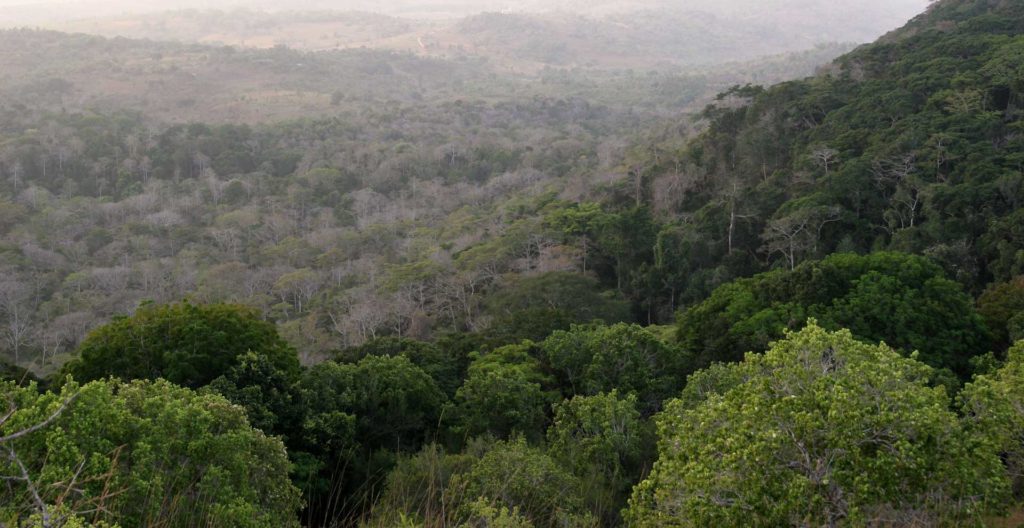
Escape to the Shimba Hills
Floating a misty-cool 400 metres above the palm-fringed beaches of Kenya’s glittering coastline, Shimba Hills National Reserve offers a unique visitor experience. The Reserve offers a blend of wood-cloaked downs, wandering elephant, breeze-fanned hills, plunging waterfalls, liana-strung jungle and the primeval stillness of one of the last remaining coastal rainforests on earth.
Famed as the only Kenyan habitat of the rare and magnificent sable antelope, Shimba Hills is just thirty minutes from the beach. It commands panoramic vistas over the Indian Ocean and plays host to one of the most enchanting tree hotels in Kenya.
Ancient forest
After the blazing brightness of the beach, these coastal hills promise cool and shade. They also offer some truly panoramic picnic sites with views stretching down the forested flanks of the escarpment to the hazy blue of the Indian Ocean. On a clear day you can also see the imposing mass of Mount Kilimanjaro rising behind the Taita Hills to the west.
The Reserve hosts one of the largest areas of coastal forest remaining in East Africa. It is also home to some of the oldest plants on earth - many of the massively buttressed forest trees being centuries old. Older still, in origin at least, are the fern-like cycads, age-mates of the dinosaurs that first flourished on earth some 200 million years ago.
Last sanctuary of the magnificent sable antelope
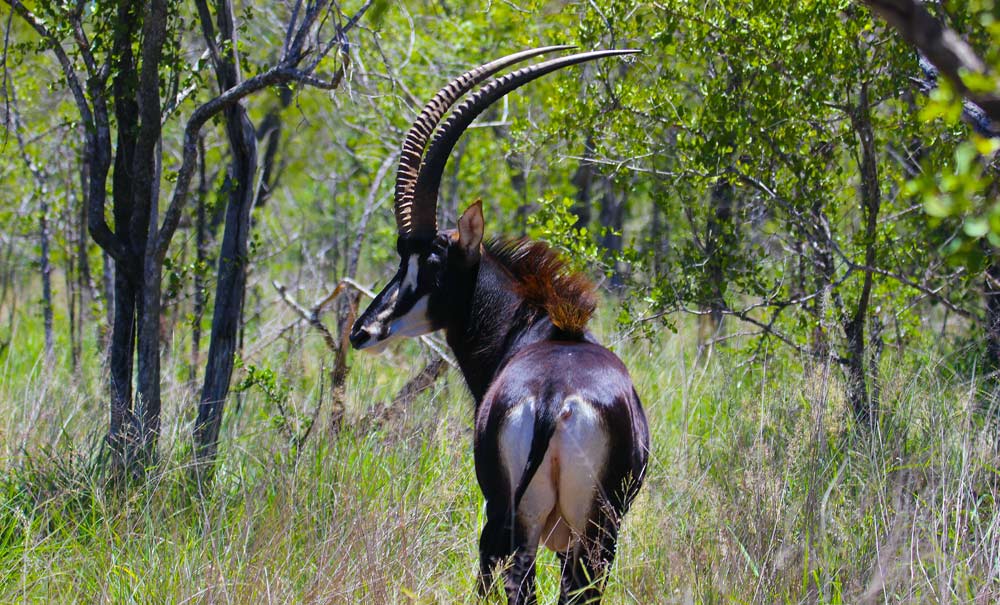
Shimba Hills offers sanctuary to Kenya's last breeding herd of indigenous sable antelope. Perhaps the most beautiful of the large antelopes, the hard-to-spot, solitary, territorial males have a satin-smooth, jet-black coat and majestic sweeping horns. While the dark reddish-brown females congregate in groups and are thus more easily spotted.
Although one of the smallest Reserves in Kenya, Shimba Hills also protects the bulk of Kenya’s black-and-white colobus population while providing shelter to a number of translocated Maasai giraffe and plains zebra.
The perfect place to spot elephants

The Reserve holds substantial numbers of elephants, which may be seen to unique advantage against the unusual backdrop of gentle downs and leafy forest. Herds can be found all over the Reserve but Elephant Hill is a good place to start.
Explore the sacred kayas
Deep in the ancient forests are a number of sacred kayas, the ancient spiritual centres of the Mijikenda people. Originally fortified residential sites, the kayas are now largely uninhabited but still widely used for sacred ceremonies and burials. Visits can be arranged through your hotel.
Read more about the sacred kayas here.
Walk in the wilderness and bathe at Sheldrick Falls
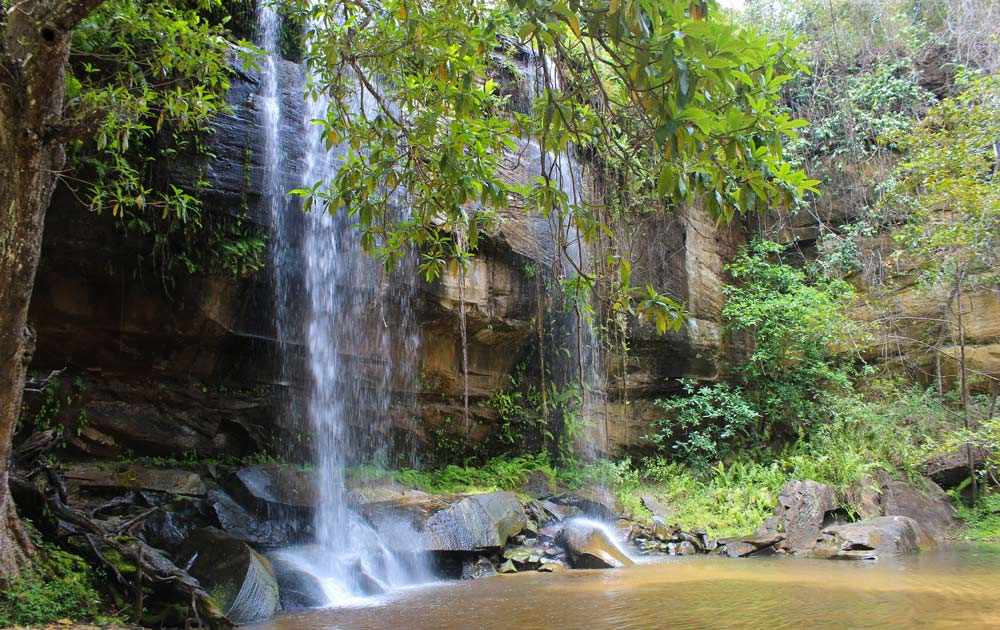
For the more energetic, the trail leading down through the lush woodlands to the spectacular torrents of the 21 metre high Sheldrick Falls offers a scenic walk, a plunge in the pool or a picnic by the cascades. You may also see blue monkey, buffalo and elephant on the way.
An ornithologist’s paradise
More than 230 species of bird have been recorded in the Reserve, which also offers sanctuary to 13 rare or restricted species. The Reserve also hosts Palaearctic birds during late March - early April. The Reserve is host to about 35% (300 species) of Kenyan butterflies.
Mwaluganje Elephant Sanctuary
Immediately adjacent to the Shimba Hills National Reserve is the spectacular Mwaluganje Elephant Sanctuary, which provides the elephants with an ancient migration route between the Shimba Hills and the Mwaluganje Forest Reserve. Home to some 150 elephants, such is wide open landscape of the sanctuary that multiple elephant sightings are guaranteed while the photo opportunities are unrivalled.
Shimba Hills - Need to know
By road, Shimba Hills is approximately 50 km south-west of Mombasa and can be easily accessed from Diani or Ukunda – buses and taxis are in plentiful supply. It is also possible to stay in an enchanting self-catering chalet with stunning views over the tree canopy.
For more information, visit the Kenya Wildlife Service website.
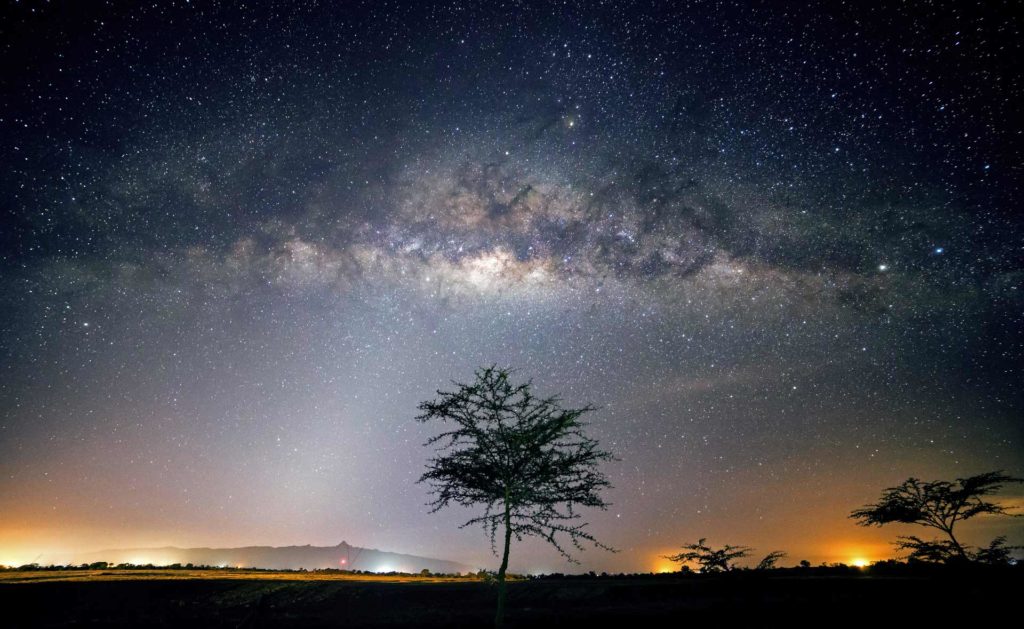
Star Gazing
The destiny of mankind is painted in the stars. Or so they say. But this is not news to the people of Loisaba. They’ve known it all along. In this part of the world, the local Samburu warriors have always lain beneath the stars. They use them to divine the nature of the coming seasons. They watch them for omens: some good, some bad. Indeed, should you get into conversation with one of these young men, he’ll probably tell you that, although he watches cable TV most nights, he learns more about current affairs from the stars than he’ll ever glean from CNN. He may also express surprise at the fact that those ‘who live close to the stars, in tall buildings that nearly touch the sky’, have only recently become aware of the phenomenon of global warming. The local Samburu seers predicted it decades ago.
Loisaba Conservancy
Loisaba, a wilderness conservancy in northern Kenya, is a star-gazers Nirvana. Its name, translated from the Samburu, means ‘the Seven Sisters’. Also known as the Pleiades, this is a particularly brilliant star cluster lying some 440 light-years from earth. But it’s only when you’re lying flat on your back beneath it that you can fully appreciate the fact that the Pleiades is one of the closest star clusters to earth. The local Samburu already know this. But then Samburu mythology claims that their original home was on the so-called ‘Morning Star’ of Venus. So they’re more star-savvy than most.
Samburu warriors, of course, don’t mind lying flat on their backs amid the velvet blackness of a lion-stalked night in order to catch up on the latest star news. Visiting space cadets, however, need beds, supper, chilled wine, and hot and cold running water.
The Elewana Loisaba Star Beds
Anchored in a sea of acacia bush punctuated by ambling herds of fudge-grey elephants, is a small flotilla of wooden arks. Single-storey platforms constructed from the contorted limbs of elephant-felled wildwood, each has a stair-ladder leading to a partially thatched wooden deck, which houses a cosy living area, shower and WC.
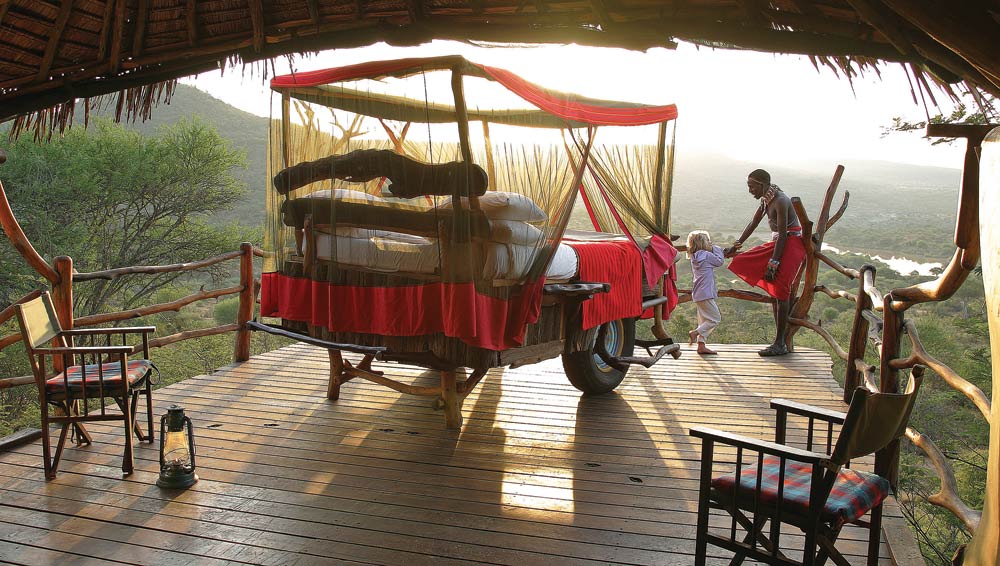
Out-thrust from this tree house is an apron of a deck. This is the stage upon which the star bed performs. A four-poster bed fashioned entirely from wildwood, bolted to a gargantuan chassis, and closely swathed in thick green net curtains, it resembles some ponderous medieval chariot. Pushed by a posse of warriors, it lumbers forth from its lair as the Seven Sisters rise in the sky. And waits for its star-gazers to climb aboard.
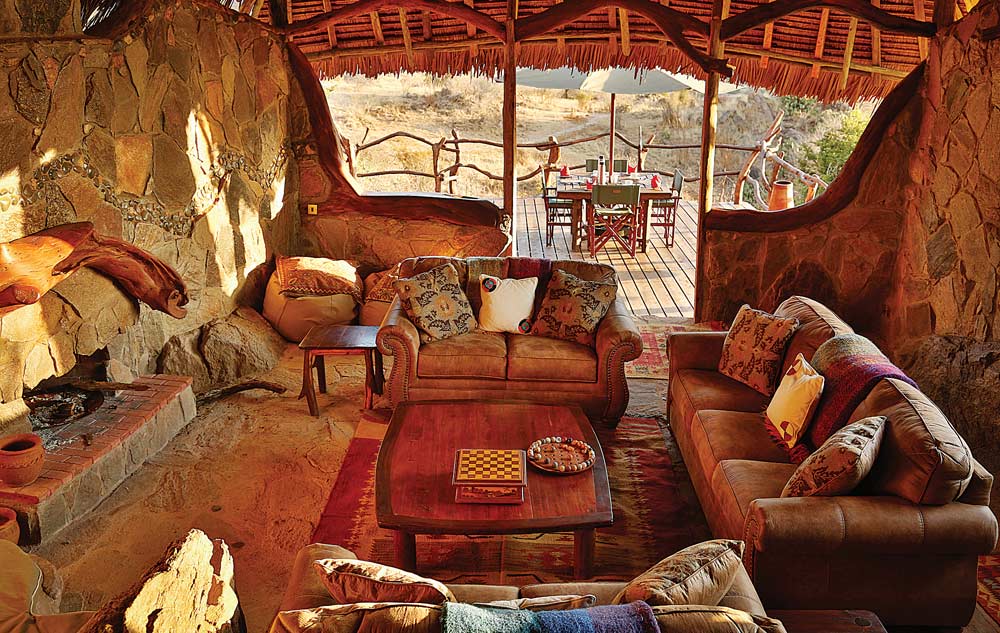
First, though, comes supper, which is staged in the quaintly elegant, stone-flagged, reception area, which lies below the star bed platform. Later you may sip your drink by the fire and chat with the star bed’s warriors. Gently diffident, impeccably polite, yet eager to converse, most of them sport a jaunty red and yellow plastic tulip, wired to their traditional Samburu headbands. Should you ask why they wear a tulip on the top of their heads, they will tell you that it should really be a blossom of indigo-blue ‘morning glory’ picked dew-fresh from the bush, and worn in celebration of the glory of the ‘Morning Star’ from which they came. But that plastic flowers are more reliable.
Eternity shines down
Night falls with conviction in Loisaba. The blackness is profound. The nearest city is hundreds of kilometers away, but the acoustics deliver all the glitter you need. There’s the gurgle of the river, the whoop of the nightjars, the rumbling of the elephants and the distant cough of a lion on the prowl. You climb the stairway to the stars, lamp in hand. The warriors depart softly to their sentry posts; you heave yourself up into a cocoon of netting, pillows, quilts, blankets and hot water bottles. And then you look up. And eternity shines down upon you. The infinite glory of the constellations rains like showers of diamonds around you. And your soul flies out to meet the Seven Sisters.
Where we stayed
The Loisaba Conservancy, 226 sq km of privately-managed wildlife conservancy, lies in the picturesque Laikipia region of Kenya, some 100 kilometres north of Nairobi. A prime example of the successful collaboration between conservation, communities and tourism, this pristine wilderness promises 250 species of birds and 50 species of mammal (including elephant, buffalo, Grevy’s zebra, greater kudu, reticulated giraffe and wild dog).
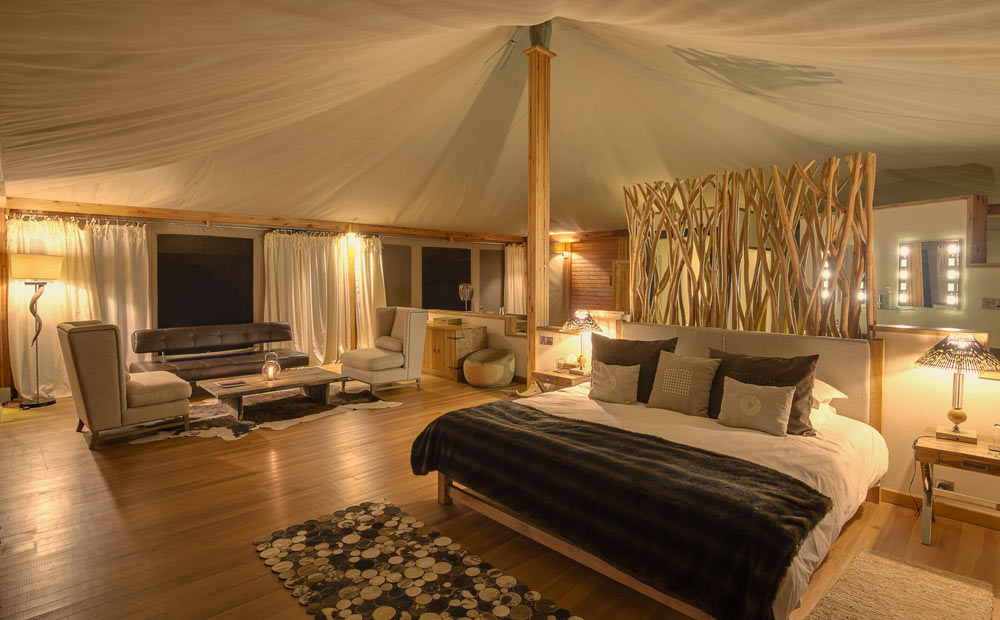
Elewana Loisaba Tented Camp offers 12 uniquely luxurious tents, two infinity pools and a central social area. Activities include: game drives, night drives, bird walks, horse-riding, camel-trekking, mountain biking, fishing, visits to the renowned anti-poaching sniffer dogs and a range of colourful cultural interactions. And, of course, the chance of a night beneath the stars at the Elewana Loisaba Star Beds.
For more information, visit: www.elewanacollection.com
Our trip was organised by Cheli and Peacock Safaris: www.chelipeacock.com
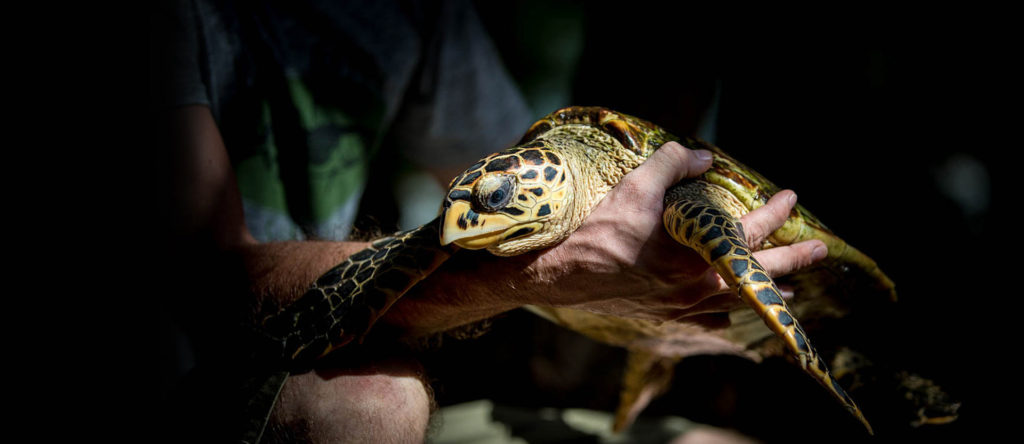
Helping save the sea turtle
Kenya's beautiful sea turtles are threatened and Watamu's Local Ocean Conservation is committed to their protection. So when visiting the Kenyan coast, be sure to find time to meet our sea turtles, which return to our beaches again and again just to lay their eggs on Kenyan sand.
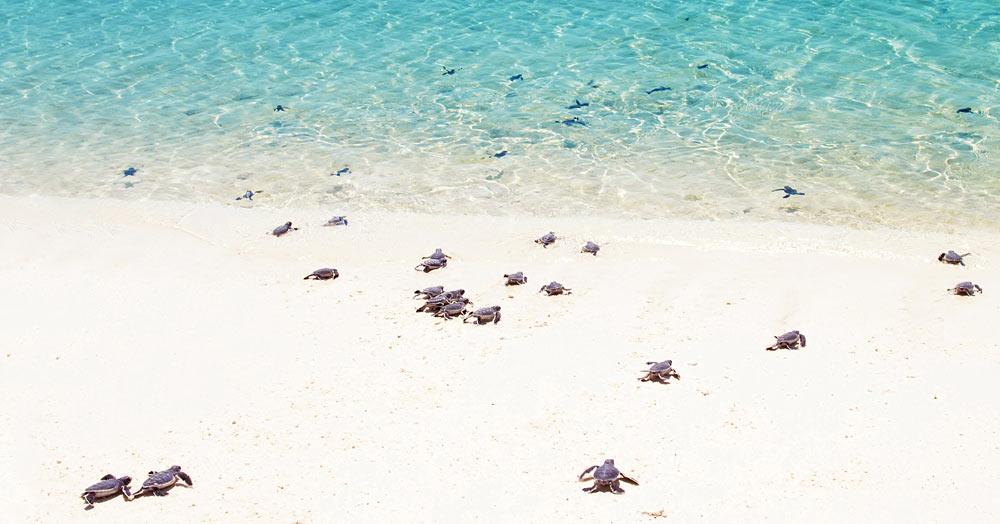
Home of the sea turtle
Kenya's Swahili coast is famous for its perfect beaches, warm, turquoise waters and exceptional marine life. The Indian Ocean, its white sands and mangrove forests, are home to one iconic creature in particular – endangered sea turtles.
A gentle creature, as old as time, the sea turtle is a mainly carnivorous reptile that lives most of its life in the ocean. When the time comes for the female to lay her eggs however, she returns with unerring instinct and over many thousands of miles to the beach where she herself was hatched. Here she excavates an egg chamber, lays her eggs, covers them with sand and slips quietly off down the sand to the sea, leaving her hatchlings to find their own way out of their shells… and down to the ocean.
Meet five out of seven of the world’s species of sea turtles
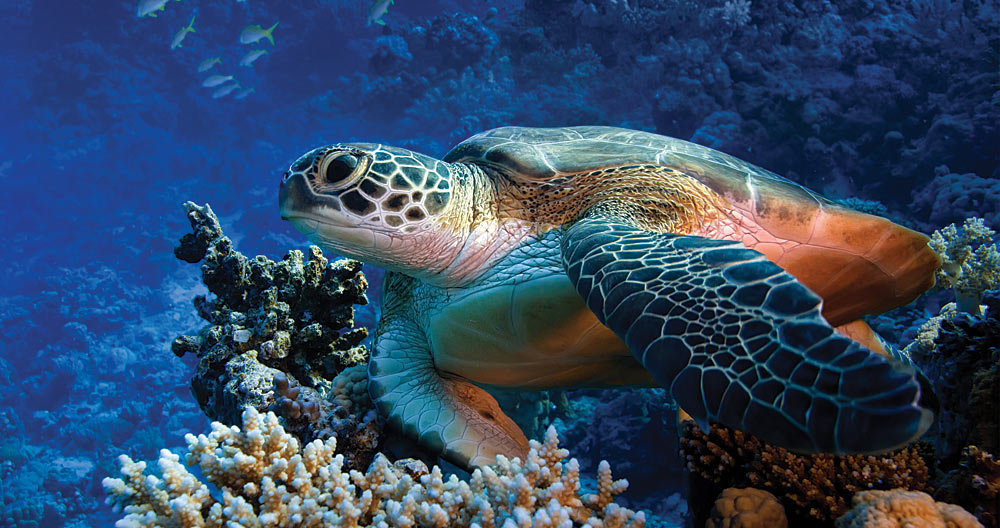
Five out of seven of the world’s species of sea turtles use the Kenyan coast as a nesting site, migrating from as far afield as South Africa and Saudi Arabia. They include: the Green, Hawksbill, Loggerhead, Olive Ridley and the Leatherback turtle; and they lay between 150 and 200 eggs each, three times per season. The Leatherback is the largest sea turtle, measuring 2–3m in length, 1–1.5 m in width, and weighing up to 700 kgs.
A very threatened creature
All seven species of sea turtle are threatened or endangered.
In its natural state, the sea turtle doesn’t have many predators, and gets on with its life in a fairly ‘live and let live’ manner. Thanks to man however, it must now face a host of challenges.
These include the development of the beach environment and the destruction of the turtle's traditional nesting sites; the destruction of mangrove forests and coral reefs; climate change and sea-level rise; and of course ocean pollution - especially plastic refuse. Turtles also get caught in the ‘gill-nets’ of the shrimp trawlers and suffer from poaching for their meat, shells, oil and eggs. As a result only one in a hundred baby turtles survive to juvenility; and only one in a thousand survive to maturity.
Protect sea turtles and protect the world
Sea turtles are a great indicator of ocean health. By protecting and enhancing the environmental conditions that sea turtles need to thrive, humanity and other species also benefit.
Get involved - visit the sea turtle rehabilitation centre
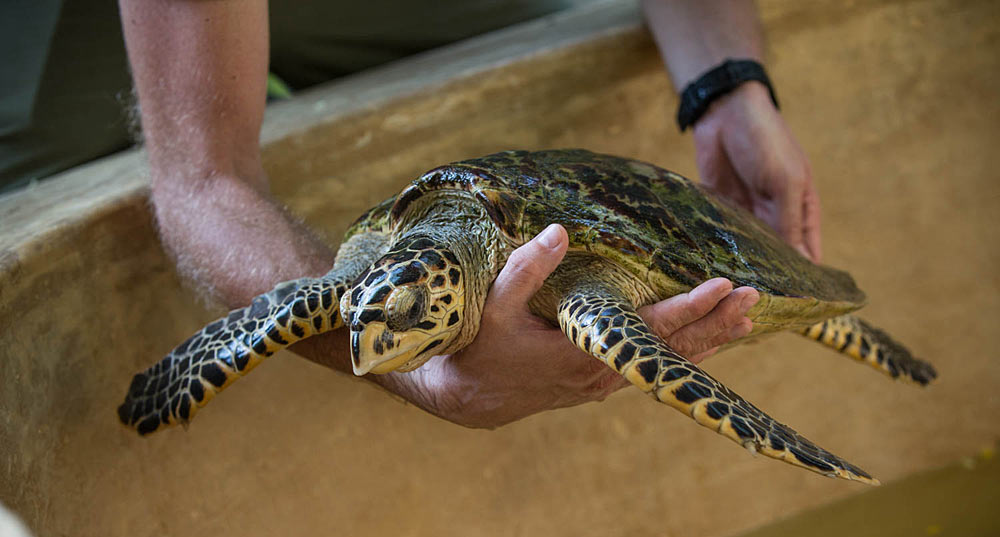
In Watamu, you can see turtle conservation in action at Local Ocean Conservation's Marine Information Centre. Here you can learn more about the marine environment, visit the recovering patients and browse around the charming gift shop. There are also opportunities for 'eco visits' where you can actually participate in the day-to-day operations of the Centre for a few weeks or longer.
If you’d like to help protect the turtle nests during the nesting season there are a number of excellent projects such as Local Ocean's Watamu Turtle Watch and Diani Turtle Watch. On average, Local Ocean protects and monitors 50-60 nests per year in Watamu and a further 60-70 nests on Kenya's south coast.
For more information on the rehabilitation centre, or how you can adopt a turtle or beach nest, visit: https://localocean.co
Want Inspiration in your Inbox?
Sign up for FREE to receive our monthly e-newsletter with features
and ideas to help you plan your Kenyan adventure
© 2025 Kenya Holidays
